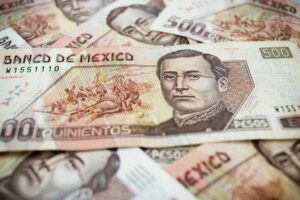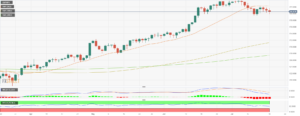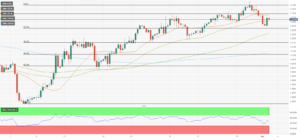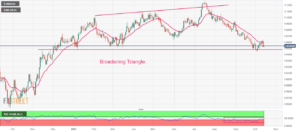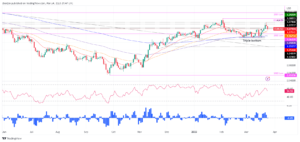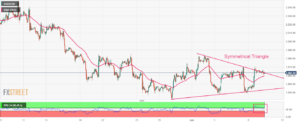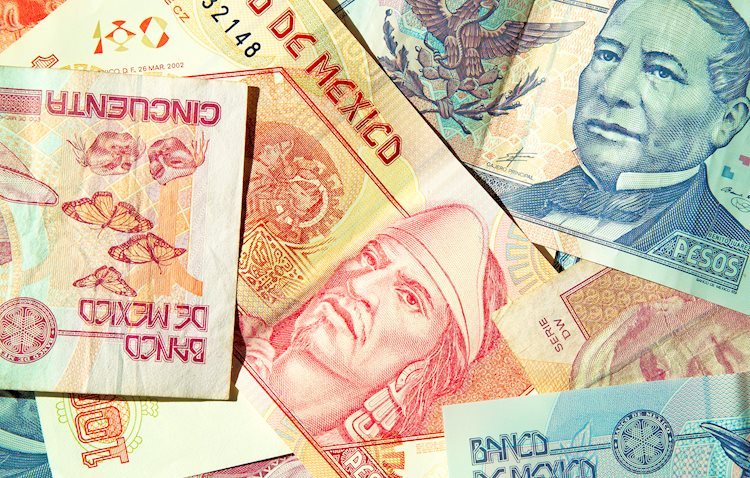
- Mexican Peso pares its losses, despite Fed official pushing back against interest rate cuts.
- The economy in the United States remains solid, according to a report by S&P Global.
- New York Fed President John Williams pushes back against rate cuts, a tailwind for USD/MXN.
- A Banxico survey shows economists expect 200 bps of rate cuts for 2024.
Mexican Peso (MXN) stays firm, reversing earlier losses against the US Dollar (USD) after the central bank bonanza on both sides of the border is finished. The divergence between the US Federal Reserve (Fed) and the Bank of Mexico (Banxico) would likely keep the USD/MXN pair trading below 18.00 for the remainder of the year. At the time of writing, the exotic pair trades at 17.18, virtually unchanged, down 0.02%.
Banxico held rates unchanged at 11.25% and maintained the tone set in the November meeting. That sponsored a leg-down in the pair, further distancing from the 100-day Simple Moving Average (SMA) key resistance level at 17.41 toward current exchange rate levels. However, the United States (US) data was solid enough to keep the pair from reaching the 17.03 latest cycle low.
In the meantime, a Banxico survey revealed that Mexican economists raised their growth forecast for 2024 from 2.10% to 2.29%, while inflation is expected to hit 4% next year. Regarding monetary policy, they expect the central bank to cut rates by 200 bps to 9.25 and the Peso to depreciate from 18.69 to 18.53.
Daily Digest Market Movers: Mexican Peso bolstered by Banxico hawkish hold
- Banxico’s decision was unanimously supported by its five members.
- The central bank acknowledged that inflation risks are tilted to the upside after November’s report witnessed headline inflation rising due to the “rise in non-core components” while core inflation eased.
- Banxico revised its inflation projections for some quarters of 2024 and 2025.
- Business activity picked up in December, according to S&P Global. The composite index, which combines manufacturing and services sectors, increased to 51, exceeding November’s 50.7 and hitting a five-month high.
- The services PMI subcomponent came in at 51.3, exceeding forecasts of 50.6, though Manufacturing slipped further, dropping to 48.2, below estimates of 49.3, and November’s 49.4
- Aside from this, the New York Fed President John Williams pushed back against the idea of rate cuts, emphatically saying it’s “premature” to think about easing policy in March.
- Williams added that the question around the Fed board is whether the policy is sufficiently restrictive enough to ensure inflation returns to 2%.
- US data on Thursday painted the economy as more resilient than expected as Retail Sales exceeded forecasts, while unemployment claims rose less than estimates.
- According to the Summary of Economic Projections (SEP), Fed officials expect to lower the federal funds rates (FFR) to 4.60% in 2024, though they remain data-dependent.
- The fall in US Treasury Bond yields, which are closely correlated to the Greenback (USD) has stalled relief for the USD, which is rising 0.43%, up at 102.40, according to the US Dollar Index (DXY).
- Money market futures estimate the Fed will slash rates by 140 basis points toward the end of next year, twice the Fed’s forecasts of three 25 bps cuts.
Technical analysis: Mexican Peso to remain range-bound at around 17.00-17.60
The USD/MXN bias is neutral to downwards biased after dropping below the 100-day SMA, seen as the last line of defense by buyers. That exposed the 17.00/05 area as the next demand area, which once surpassed, could open the door for a retest of the year-to-date (YTD) low of 16.62
On the other hand, if buyers reclaim the 100-day SMA at 17.41, the USD/MXN could rally toward the 200-day SMA at 17.52, followed by the 50-day SMA at 17.60. Further upside is seen at around 18.00.
Interest rates FAQs
Interest rates are charged by financial institutions on loans to borrowers and are paid as interest to savers and depositors. They are influenced by base lending rates, which are set by central banks in response to changes in the economy. Central banks normally have a mandate to ensure price stability, which in most cases means targeting a core inflation rate of around 2%.
If inflation falls below target the central bank may cut base lending rates, with a view to stimulating lending and boosting the economy. If inflation rises substantially above 2% it normally results in the central bank raising base lending rates in an attempt to lower inflation.
Higher interest rates generally help strengthen a country’s currency as they make it a more attractive place for global investors to park their money.
Higher interest rates overall weigh on the price of Gold because they increase the opportunity cost of holding Gold instead of investing in an interest-bearing asset or placing cash in the bank.
If interest rates are high that usually pushes up the price of the US Dollar (USD), and since Gold is priced in Dollars, this has the effect of lowering the price of Gold.
The Fed funds rate is the overnight rate at which US banks lend to each other. It is the oft-quoted headline rate set by the Federal Reserve at its FOMC meetings. It is set as a range, for example 4.75%-5.00%, though the upper limit (in that case 5.00%) is the quoted figure.
Market expectations for future Fed funds rate are tracked by the CME FedWatch tool, which shapes how many financial markets behave in anticipation of future Federal Reserve monetary policy decisions.
- SEO Powered Content & PR Distribution. Get Amplified Today.
- PlatoData.Network Vertical Generative Ai. Empower Yourself. Access Here.
- PlatoAiStream. Web3 Intelligence. Knowledge Amplified. Access Here.
- PlatoESG. Carbon, CleanTech, Energy, Environment, Solar, Waste Management. Access Here.
- PlatoHealth. Biotech and Clinical Trials Intelligence. Access Here.
- Source: https://www.fxstreet.com/news/mexican-peso-falls-after-feds-williams-dismisses-rate-cut-in-march-202312151530
- :has
- :is
- ][p
- $UP
- 102
- 11
- 16
- 17
- 2%
- 200
- 2024
- 2025
- 25
- 28
- 32
- 33
- 40
- 41
- 49
- 50
- 51
- 52
- 53
- 60
- 7
- 9
- a
- About
- above
- According
- acknowledged
- activity
- added
- After
- against
- Amid
- an
- analysis
- and
- Animate
- anticipation
- ARE
- AREA
- around
- AS
- asset
- At
- attempt
- attractive
- average
- back
- Bank
- Banks
- base
- basis
- because
- below
- between
- bias
- biased
- board
- bond
- Bond yields
- boosting
- border
- borrowers
- both
- Both Sides
- buyers
- by
- came
- case
- cases
- Cash
- central
- Central Bank
- Central Banks
- Changes
- charged
- claims
- closely
- CME
- combines
- content
- Core
- core inflation
- correlated
- Cost
- could
- country’s
- Currency
- Current
- Cut
- cuts
- cycle
- data
- December
- decision
- decisions
- Defense
- Demand
- depositors
- depreciate
- Despite
- Digest
- Divergence
- Dollar
- dollar index
- dollars
- Door
- down
- Dropping
- due
- Dxy
- each
- Earlier
- easing
- Economic
- economists
- economy
- effect
- end
- ends
- enough
- ensure
- estimate
- estimates
- example
- exceeded
- exchange
- Exchange rate
- Exotic
- expanded
- expect
- expectations
- expected
- exposed
- Fall
- Falls
- FAQ
- Fed
- fed funds rate
- Federal
- federal reserve
- Figure
- financial
- Financial institutions
- Firm
- five
- followed
- FOMC
- For
- Forecast
- forecasts
- from
- funds
- further
- future
- Futures
- generally
- Global
- Gold
- Greenback
- Growth
- hand
- Have
- Hawkish
- headline
- Held
- help
- High
- Hit
- hitting
- holding
- holds
- How
- However
- HTTPS
- idea
- if
- in
- Increase
- increased
- index
- inflation
- inflation rate
- Inflation rising
- influenced
- instead
- institutions
- interest
- INTEREST RATE
- Interest Rates
- investing
- Investors
- IT
- ITS
- John
- jpg
- Keep
- Key
- key resistance
- Last
- latest
- LEND
- lending
- less
- Level
- levels
- likely
- LIMIT
- Line
- Loans
- losses
- Low
- lower
- lowering
- make
- mandate
- manufacturing
- many
- March
- Market
- Markets
- May..
- means
- meantime
- meeting
- meetings
- Members
- Mexico
- module
- Monetary
- Monetary Policy
- money
- more
- most
- Movers
- moving
- moving average
- Neutral
- New
- New York
- New York Fed
- next
- normally
- November
- of
- official
- officials
- on
- once
- open
- Opportunity
- or
- Other
- overall
- overnight
- paid
- pair
- Park
- Peso
- picked
- Place
- placing
- plato
- Plato Data Intelligence
- PlatoData
- pmi
- points
- policy
- positive
- president
- price
- projections
- pushed
- pushes
- Pushing
- question
- raised
- raising
- rally
- range
- Rate
- Rates
- reaching
- regarding
- relief
- remain
- remainder
- remains
- report
- Reserve
- resilient
- Resistance
- response
- Restrictive
- Results
- retail
- Retail Sales
- returns
- Revealed
- Rises
- rising
- risks
- ROSE
- S&P
- S&P Global
- sales
- Savers
- saying
- Sectors
- seen
- Services
- set
- shapes
- Shows
- Sides
- Simple
- since
- SMA
- solid
- some
- Sponsored
- Stability
- starts
- States
- steady
- Strengthen
- substantially
- SUMMARY
- Supported
- surpassed
- Survey
- Tailwind
- Target
- targeting
- than
- that
- The
- the Fed
- The US Federal Reserve
- their
- they
- think
- this
- though?
- three
- thursday
- time
- to
- TONE
- tool
- toward
- trades
- Trading
- treasury
- Twice
- unanimously
- unemployment
- United
- United States
- Upside
- us
- US banks
- US Dollar
- US Dollar Index
- US Federal
- us federal reserve
- US Treasury
- USD
- usually
- View
- virtually
- was
- weigh
- whether
- which
- while
- will
- Williams
- with
- witnessed
- would
- writing
- year
- yields
- york
- zephyrnet



